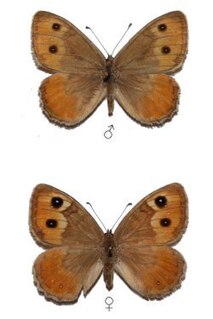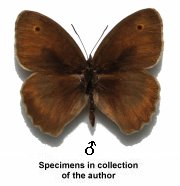
The meadow brown is a butterfly found in the Palearctic realm. Its range includes Europe south of 62°N, Russia eastwards to the Urals, Asia Minor, Iraq, Iran, North Africa and the Canary Islands. The larvae feed on grasses.

Leopardus is a genus comprising eight species of small cats native to the Americas. This genus is considered the oldest branch of a genetic lineage of small cats in the Americas whose common ancestor crossed the Bering land bridge from Asia to North America in the late Miocene.
Agriades zullichi is a species of butterfly in the family Lycaenidae. It is endemic to Spain.

Pseudochazara atlantis is a species of butterfly in the family Nymphalidae. It is endemic to Morocco. It flies in barren rocky slopes. The male is found only on large tabular spaces and bare mountain peaks, while the female wanders on the slopes, both for foraging the flowers of Compositae or thyme and to lay her eggs.
Hipparchia sbordonii, the Ponza grayling, is a butterfly of the family Nymphalidae. It is an endemic species found only on the Pontine Islands of Italy.

The World's 25 Most Endangered Primates is a list of highly endangered primate species selected and published by the International Union for Conservation of Nature Species Survival Commission Primate Specialist Group, the International Primatological Society (IPS), and Conservation International (CI). The 2012–2014 list added the Bristol Conservation and Science Foundation (BCSF) to the list of publishers. The IUCN/SSC PSG worked with CI to start the list in 2000, but in 2002, during the 19th Congress of the International Primatological Society, primatologists reviewed and debated the list, resulting in the 2002–2004 revision and the endorsement of the IPS. The publication has since been a joint project between the three conservation organizations and has been revised every two years following the biannual Congress of the IPS. Starting with the 2004–2006 report, the title changed to "Primates in Peril: The World's 25 Most Endangered Primates". That same year, the list began to provide information about each species, including their conservation status and the threats they face in the wild. The species text is written in collaboration with experts from the field, with 60 people contributing to the 2006–2008 report and 85 people contributing to the 2008–2010 report. The 2004–2006 and 2006–2008 reports were published in the IUCN/SSC PSG journal Primate Conservation, while the 2008–2010 and 2010-2012 report were published as independent publications by all three contributing organizations.

Melanargia titea, the Levantine marbled white, is a butterfly of the family Nymphalidae. It is found in Syria, Jordan, the Palestinian Territories, Israel, Armenia, Iran and Turkey.

Polyommatus golgus, the Sierra Nevada blue, is a species of butterfly in the family Lycaenidae. It is endemic to Spain with habitat in the Sierra Nevada in Andalusia, and is an endangered species.
Pyrgus aladaghensis, also known as the Aladagh skipper or Aladag skipper, is a butterfly of the family of Hesperiidae that was first described by Willy De Prins and Dirk van der Poorten in 1995. It is found on the Aladaglar massive of the Taurus Mountains near Niğde, in southern Turkey.







